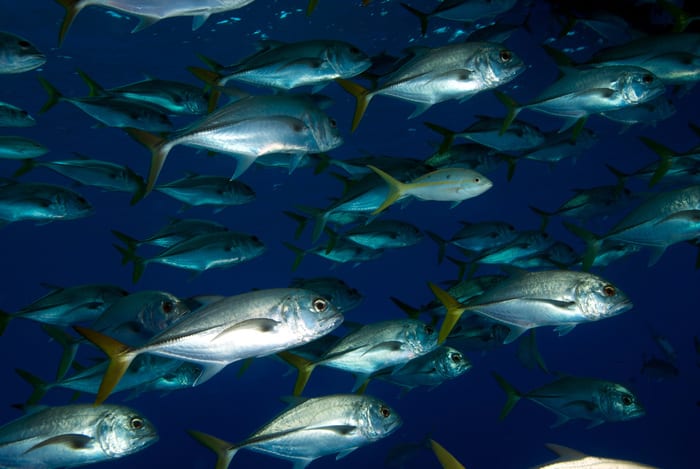
It is important for USSEC to both monitor anticipated changes in the seafood industry and to provide insights to the greater seafood industry on how these changes will impact issues related to aquaculture and aquaculture feeds specifically. USSEC’s aquaculture program recently took part in a webinar, “IntraFish Digital Events: Plant and cell-based seafood: A Threat or Opportunity?” on cell and plant-based seafood substitutes.
“Alternative seafood – items made of plants or grown in labs – is attracting investment from major food companies and investors, and the trend is reflective of significant changes in consumer eating patterns,” IntraFish described the event. “Plant-based seafood sales account for $9.5 million of the $939 million in sales of plant-based meat items, small in comparison to the $100 billion worth of seafood sold in the United States annually. But the growth trajectory of plant-based foods is stunning, and a clear part of food's future. The seafood industry, initially wary of alternative-seafood products, seem to be embracing the segment, with major groups like Bumble Bee and Frosta partnering with suppliers, or launching lines of their own.”
A dynamic group of speakers discussed and debated how seafood companies, investors, and buyers should view this emerging trend. The total number of participants was not provided by IntraFish, but the webinar targeted key seafood industry stakeholders, including aquaculture. Lukas Manomaitis, USSEC Aquaculture Program Technical Contractor took part in this event.
USSEC has had an active program in aquaculture for 35 years and has had many notable successes in moving the aquaculture industry to better, feed-based approaches that use U.S. Soy. This webinar discussed an interesting juxtaposition for the USSEC aquaculture and USSEC human nutrition (HU) approaches. We know that soy can be used to feed aquatic livestock, but soy is also being used to replace seafood products through direct substitutes using plant-based protein. Substitution is also being done through cell-based approaches, but the main relevance of this webinar was to discuss aqua production and substitute plant-based seafood proteins.
Those who live in the United States are likely familiar with the “Impossible Burger” and “Beyond Meat” that have entered the food supply chain. These have largely targeted terrestrial animal livestock protein replacements. But there are efforts underway to attempt to do something similar for seafood proteins (aquatic livestock). This can be done through cell-based culture (where muscle, fat and connective tissue cells are grown in vats and combined to make an actual “seafood”) and plant-based protein which uses various plant products to try to mimic the taste and texture of seafood.
Soy, particularly U.S. Soy, benefits from both traditional aquaculture production of seafood and from plant-based seafood replacements. This is because most plant-based replacements use products such as soy to create their products, often with a mix of different beans, algae, and other non-meat ingredients. As many of these new companies are based in the United States, this means that U.S. Soy is likely the main component of these products.
From the perspective of the seafood industry, the question is whether these alternative seafood protein approaches are a challenge or an opportunity.
A spirited discussion took place between the six panelists on this topic, and it was clear that the main tension was between traditional seafood and plant-based seafood substitutes, with little concern about cell-based seafood production. Key issues were discussed about how these new plant-based seafood proteins are marketing themselves and their safety, particularly in light of their highly processed nature. The seafood panelist noted that he had concerns that the labeling of these products may deceive consumers, about the nutritional value of the products, and the negative marketing approach that these new proteins use to compare them to traditional seafood. The investment company panelist noted that companies needed to think more broadly rather than just focusing on one protein supply, so having a mix allows them to succeed no matter the world situation (and allows them to target a wider customer base). Instead of having “meat” companies, we will have “protein” companies. [This mirrors what USSEC is doing by combining the terrestrial and aquatic livestock programs under one senior director.] The plant-based seafood protein panelists noted that people are becoming more “flexitarian” and want more options, but that palatability is important. It should also be noted that many of the plant-based seafood proteins use seaweed or algal products which are often done through aquaculture, just not feed-based.
At the end of the panelists’ discussion, there was a conversation about where there might be a scope for more collaboration, through “blended” products that use both traditional seafood protein combined with plant-based seafood protein. This is already happening with products like soy tuna produced in Thailand and sent to India, which is only 10% “real” tuna protein.
No matter the outcome, U.S. Soy will likely benefit as it will have a role in both supporting the culture of seafood through feed and in supplying soy for the creation of new products like plant-based seafood proteins.
“Companies will need to have a ‘portfolio of proteins’ in the future as there are challenges to food security and requirements for a stable and flexible supply chain,” says Joost Matthijssen, Investment Director of Nutreco.
U.S. Soy wins on both sides of this discussion. USSEC’s aquaculture utilization program is helping with the promotion of the use of more U.S. Soy into aquaculture feeds and USSEC HU shows the benefit and uses of soy in various products. If both sides expand, then U.S. Soy will benefit without having to worry which approach “wins.”
This is important on a global level as seafood is one of the most traded commodities in the global market and U.S. Soy can be used for proteins that people will eat.
